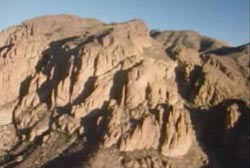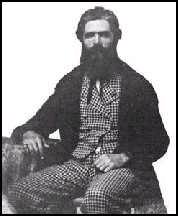Case File: The Lost Dutchman Mine
Location: The Superstition Mountains, Arizona
Date: 1876
Description: The Superstition Mountains in Arizona cover 160,000 acres of desolate, rugged terrain.
Case[]
History: The Lost Dutchman Mine is possibly one of the famous lost treasures in history. According to legend, somewhere hidden in the Superstition Mountains lie the richest deposits of gold in America - the Lost Dutchman's Gold Mine. The mine was founded by Jacob Waltz, nicknamed "The Dutchman". The exact location of the Lost Dutchman's Mine remains a mystery. For over a century, treasure hunters have occasionally claimed that they have clues to Jacob's lost mine. A few of them may have even found it. Curiously, they all died before they could tell their tale.
In 1984, over 100 years after the Dutchman sealed up the mine in 1876, a modern-day treasure hunter claimed that he had found the mine. Using clues handed down from Jacob's death-bed description, Phoenix chef Walter "Walt" Gassler spent most of his free time looking for the legendary mine. However, when his health began to fail, Walt contacted two other prospectors. One of them was Bob Corbin, who was then the Attorney General of Arizona. He hoped that Bob could search for the mine after he died. He gave Bob his notes as well as a map of the area, which included the location of his camp and his suspected location of the mine.
The other prospector Walt contacted was Bob's partner Tom Kollenborn, a local historian. Two months after Walt met with Bob, he called Tom. Walt as excited and claimed that he had finally found the mine. He asked Bob and Tom to come with him that night; however, Tom said that he could not go until the next day. Walt decided to go alone. The next morning, his wife dropped him off at a trail head. He then hiked into the Superstition Mountains, never to be seen alive again. Three days later, ranch-hand Don Shade found his body. An autopsy showed that he had died of a heart attack. Don believed that he had been dead for two or three days.
One month after Walt's death, Tom Kollenborn had a surprising visit from a man claiming to be Roland Gassler, Walt's son. He claimed that his father had found the mine; he produced a gold brick from his father's possessions as "proof" of his identity. The brick looked very similar to the gold that allegedly came out of the Dutchman's mine. Roland then asked about a map that belonged to his father. Tom told him that he no longer had the map; however, he did gave him Walt's manuscripts.
Two months later, as Tom was finishing a slide lecture, he was approached by another stranger who claimed he was Roland Gassler. Tom was shocked and asked for the man's driver's license. The license was legitimate; this man was the real Roland Gassler. Tom then wondered who the other man claiming to be Roland really was. It appeared that he was an impostor who needed Walt's map so he could search for himself.
Tom wondered how the impostor obtained the gold brick. In the sheriff's report from Walt's death, a brown backpack was listed among his belongings. However, the real Roland Gassler never received it. Don Shade, the man who found Walt's body, also remembered seeing the backpack. He also recalled seeing a stranger in the area. The description of this man matched the description of the impostor. It is believed that the impostor stole the backpack from Walt's body.
Since then, the Superstition Mountains have been reclassified as a federally owned wilderness area. If the mine were found today, all the gold would belong to the government. However, this does not deter other treasure hunters from searching for the Lost Dutchman.
Background: The Lost Dutchman Mine was founded by a German prospector named Jacob "The Dutchman" Waltz in 1876. He was a student of mining and was knowledgeable in geology. He knew that gold had been found in the Superstition Mountains. He was one of the few who were well-prepared to prospect in unpromising locations. Apparently, he was rewarded.
Fifteen years later in 1891, eighty-year-old Jacob decided to hide his mine. He is said to have dug a hole six feet deep at the entrance of the mine. He then laid in two solid layers of iron wood logs, filled the hole with dirt, and then topped it with stones from the surrounding area. He bragged that someone could drive a pack train over the entrance of the mine and never know it was there.
Several months after Jacob hid the mine, he contracted pneumonia and was taken to the home of a friend, Julia Thomas, in Phoenix. She tried to nurse him back to health, but was unsuccessful. Before he died, he told her that there was gold from the mine stashed under his bed. He told her that he has been living on it for several years. When she pulled out the gold, she was shocked at how much was there. He claimed that there was at least $20 million worth of gold in the mine.
As his end drew near, Jacob gave Julia and a local miner, Rhinehart Petrasch, clues to the mine. However, he also said that the clues may not be enough and that he may need to take them to the mine himself. Unfortunately, he died before he could give them a map to show where exactly the mine was located. Even though there are hundreds of maps in existence today, none came from Jacob.
Julia, Rhinehart, and Rhinehart's brother Hermann decided to venture into the Superstition Mountains to try and find the mine. The only clues they had were the verbal clues that Jacob had given them on his death bed. He said that "the setting sun shines into the entrance of the mine and glitters on the gold". This would mean that the mine faces to the West. He also said that "you take the first gorge on the south side from the west end of the range". He also said that "you can see Weaver's Needle to the south from above my mine".
Julia and the Petrasch brothers were so anxious to get into the mountains that they went in the mid-summer, when it was extremely hot. They were in the mountains for about five weeks; however, they found no trace of the gold. Julia had invested everything that she owned into the expedition. Unfortunately, she returned penniless and never attempted to return to the Superstition Mountains.
Rhinehart was accused by his brother Herman of not paying enough attention at Jacob's bedside and writing the clues down incorrectly. The brothers never spoke again. Rhinehart continued to search sporadically for the mine over the next fifty years. When his eyesight began to fail, he realized he would never find it. He then took his own life.
Investigations: Julia Thomas, Rhinehart Petrash, and his brother Hermann searched for the mine shortly after receiving the clues from Jacob. However, they were never able to find it. Rhinehart continued searching for it for over fifty years. However, when he realized that he would never find it, he committed suicide.
In 1984, modern-day treasure hunter Walt Gassler began searching for the mine. He believed that he was close to finding the mine. However, he died of a heart attack before discovering it. Prospectors Bob Corbin and Tom Kollenborn helped Walt in his search for the mine.
Extra Notes: This case originally ran on the March 15, 1989 episode. The case was also mentioned on the show Disappeared, featured in an episode about missing prospector Jesse Capen.
Walt's family declined to participate in the broadcast.
Results: Unsolved. Sadly, Tom Kollenborn passed away in 2018 at the age of eighty.
Links:
- Lost Dutchman's Mine on Unsolved.com
- Lost Dutchman's Mine on Wikipedia
- Lost Dutchman's Mine on Legends of America
- Lost Dutchman's Mine on DesertUSA
- The Superstition Mountains Museum
- Attorney to appear in TV show
- Arizona attorney general playing role in Mysteries
- NBC digs into Lost Dutchman mystery
- In His Search for Gold, Bob Corbin Found Charles Keating
- Mountains still lure prospectors in search of lost lode
- Arizona's Unsolved Mysteries
- The Legend of the Lost Dutchman's Mine
- Tom Kollenborn, author, cowboy and Lost Dutchman expert, dies at 80
- Local Historian Tom Kollenborn Passes at 80
- Jacob "Lost Dutchman" Waltz at Find a Grave



